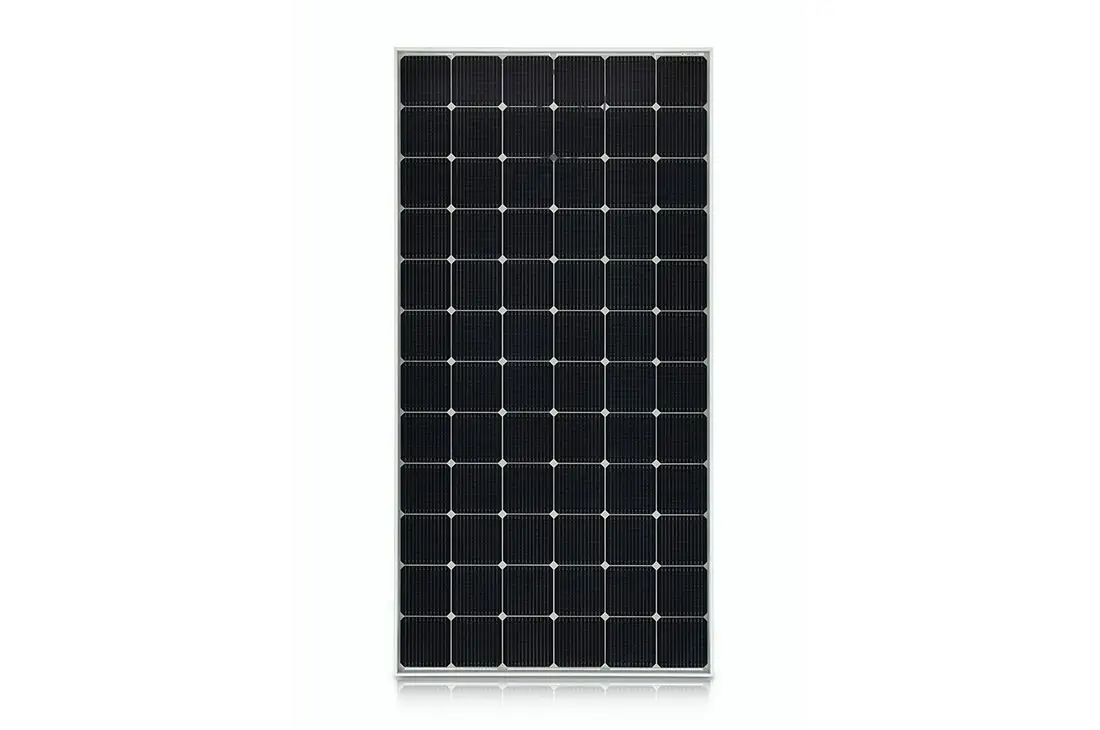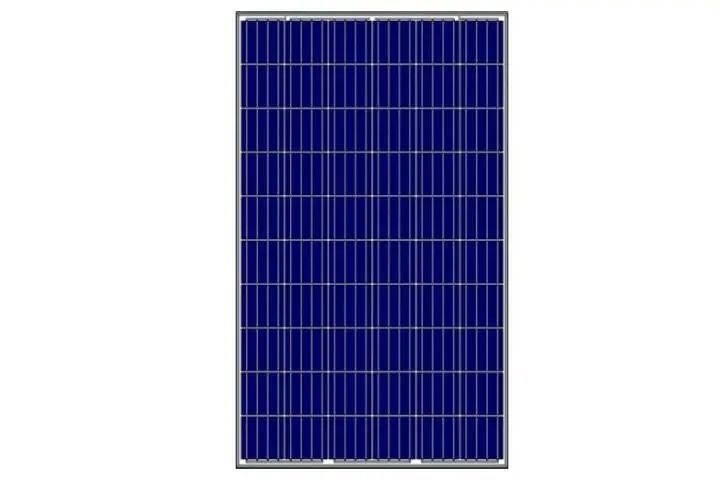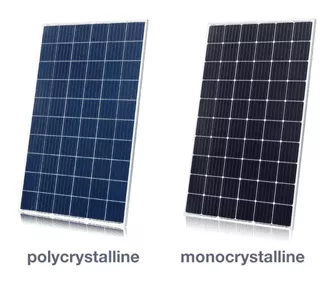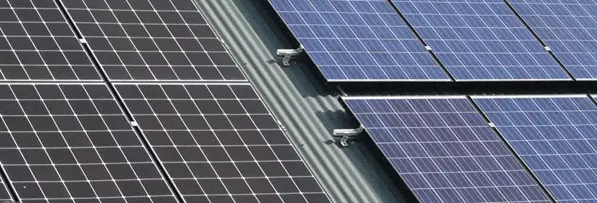Quando si valutano i pannelli solari per i sistemi fotovoltaici, incontrerai due grandi categorie di pannelli: pannelli fotovoltaici solari policristallini vs policristallini. Questo articolo descrive in dettaglio le differenze chiave tra questi due tipi di pannelli solari in modo da poter determinare il miglior pannello solare per la tua casa.
Tipi di pannelli solari
I pannelli solari attualmente sul mercato sono principalmente divisi in tre tipi: singolo cristallo, policristallo e film sottile.
Pannelli solari monocristallini

Silicio monocristallino pannelli solari, noto anche come pannelli monocristallini, sono i pannelli solari più popolari utilizzati nelle installazioni di pannelli solari sul tetto oggi. Sono realizzati con un singolo cristallo di silicio puro tagliato in più wafer e hanno un aspetto uniforme e un colore nero intenso. L'uso del silicio puro li rende noti per la loro alta efficienza e piccole dimensioni, rendendoli i più efficienti e durevoli di tutti e tre i tipi di pannelli solari.
Pannelli solari policristallini

Polisilicon silicio I pannelli solari sono realizzati in polisilicio, che deriva da diversi cristalli di silicio che di solito hanno un aspetto blu e hanno confini irregolari tra i grani. I pannelli solari polisilicon sono più economici, e la loro purezza e struttura del silicio sono inferiori ai pannelli a cristallo singolo, Ma questo li rende anche meno efficienti in termini di conversione dell'energia, spazio, e resistenza al calore.
Pannelli solari a film sottile

Oltre a monocristallino vs policristallino, Ci sono pannelli solari a film sottile. I pannelli a film sottile sono caratterizzati da strati molto fini e sottili, e spesso hanno vantaggi in termini di flessibilità e leggero. Ogni pannello non richiede il supporto del telaio, rendendoli più leggeri e più facili da installare. A differenza dei pannelli di silicio cristallino, che sono standardizzati nelle dimensioni di 60, 72 E 96 cellule, I pannelli a film sottile possono essere realizzati in diverse dimensioni per soddisfare le esigenze specifiche. Tuttavia, Sono meno efficienti dei tipici pannelli solari di silicio.
Cosa sono pannelli fotovoltaici solari monocristallini vs policristallini

I pannelli solari policristallini vs policristallini sono i due tipi più comuni di pannelli solari. Entrambi usano le celle fotovoltaiche realizzate in silicio, lo stesso materiale usato in patatine elettroniche. Come tutti i pannelli solari, Catturano l'energia solare e la convertono in elettricità.
Esistono due tipi di piastre di silicio monocristallino:
- Emettitore passivato e post -contatto (PERC) pannelli: I pannelli PERC sono più comunemente utilizzati per le installazioni sul tetto. Le loro celle fotovoltaiche hanno uno strato conduttivo aggiuntivo sul retro per aumentare l'assorbimento di energia.
- Pannelli a doppia faccia: I pannelli a doppia faccia possono assorbire la luce su entrambe le facce e avere un tasso di assorbimento più elevato rispetto ai pannelli Perc. Di solito sono riservati a sistemi montati a terra, lasciando esposti entrambi i lati del pannello. I pannelli a doppia faccia vengono utilizzati anche per le tende, baldacchini e tetti commerciali bianchi altamente riflettenti.
I pannelli di silicio policristallino sono fabbricati utilizzando la precedente tecnologia solare, Quindi sono più economici dei nuovi pannelli di silicio monocristallino. Tuttavia, A causa della tecnologia più vecchia, I pannelli policristallini sono meno efficienti delle loro moderne controparti.
Differenza tra pannelli fotovoltaici solari monocristallini e policristallini
Efficienza dei pannelli Mono vs Poly Solar
L'efficienza del pannello solare indica quanto bene i tuoi pannelli convertono l'energia solare in elettricità, espresso in percentuale, Maggiore è l'efficienza, Più elettricità generata. Per esempio, Un'efficienza di 20% significa questo 20% della radiazione solare viene convertita in elettricità, mentre manca 80% viene convertito in calore.
Generalmente, I pannelli solari monocristallini sono più efficienti dei pannelli solari policristallini perché vengono tagliati dal silicio monocristallino, Rendendo più facile per la massima quantità di elettricità muoversi attorno all'intero pannello. L'efficienza dei pannelli di silicio monocristallino è tra 15% E 25%, e l'efficienza dei pannelli solari policristallini è inferiore, A 14% A 17%.
Un altro vantaggio dei pannelli solari monocristallini è che la purezza cristallina delle loro celle fa sì che la loro produzione inizi prima e si interrompa più tardi rispetto ai pannelli solari policristallini.. Questo tipo di pannello non è solo più efficiente, ma ha anche un periodo di generazione di energia più lungo rispetto ai pannelli solari policristallini.
Prezzo mono vs poli solare
Quando si confrontano i pannelli individualmente, I pannelli solari monocristallino sono più costosi dei pannelli solari policristallini. I pannelli solari policristallini in genere costano tra $0.40 E $0.50 per watt, mentre i pannelli solari monocristallino costano tra $0.50 E $0.80 per watt.
Ma ciò non significa che un pannello solare a cristallo singolo potrebbe non essere la scelta migliore, e la struttura del silicio è il fattore principale che determina la differenza di costo tra questi due tipi di pannelli solari. Per produrre pannelli policristallini, I produttori devono semplicemente versare silicio fuso in uno stampo quadrato e quindi tagliare i wafer risultanti in singoli cellule. Al contrario, Per produrre pannelli a cristalli singoli, La solidificazione del silicio deve essere controllata con molta attenzione, e il processo di pannelli a cristalli singoli è più complesso, che rende le celle solari a cristallo singolo più costose.
Durata
Il tipo di cella di silicio che costituisce un pannello solare di solito non influisce sulla durata del pannello. Se mantenuto correttamente, Entrambi i pannelli policristallini monocristallini vs possono generare in modo efficiente l'elettricità per 25 anni o più.
Entrambi i tipi di pannelli solari sono dotati di due garanzie, una garanzia fisica e una garanzia di efficienza. Le garanzie fisiche sono in genere 15 A 30 anni e coprire qualsiasi danno fisico.
Estetica

L'aspetto di una cella solare è anche il risultato della sua struttura in silicio, e la principale differenza estetica tra i pannelli solari monocristallini e policristallini è il loro colore: i pannelli monocristallo sono generalmente neri, mentre i pannelli policristallini possono apparire blu. Le persone generalmente preferiscono l'aspetto dei pannelli solari monocristallino, e i pannelli neri possono fondersi meglio con più tetti.
Coefficiente di temperatura
Il coefficiente di temperatura indica il grado in cui un pannello solare è influenzato dalla temperatura. Tutti i pannelli solari vengono testati in fabbrica nelle stesse condizioni di prova standard (STC) per garantire un confronto equo. Maggiore è il coefficiente di temperatura, tanto più la potenza del pannello diminuisce a temperature esterne a tale intervallo.
Generalmente, i pannelli solari policristallini tendono ad avere un coefficiente di temperatura più elevato, Ciò significa che sono meno produttivi alle alte temperature. Il coefficiente di temperatura della piastra di silicio monocristallina è basso e la resistenza al calore è buona.
Che è meglio pannelli mono o poli solari
Ogni tipo di pannello solare presenta vantaggi e svantaggi, Ed entrambi possono guadagnare un buon ritorno sugli investimenti. La tua decisione dipende dalle tue preferenze personali, Vincoli di spazio e opzioni di finanziamento.
Vuoi un colore specifico di pannelli solari?
Se pensi che il colore dei pannelli solari sia importante, Ricorda che il colore dei pannelli di silicio monocristallino vs policristallino non sono gli stessi. Il pannello a cristallo singolo è nero, mentre il pannello policristallino è blu. Puoi acquistare pannelli solari che si adattano ai tuoi gusti.
Quanto spazio hai per i pannelli solari?
Se la dimensione del sistema fotovoltaico è limitata dallo spazio disponibile sul tetto, pannelli in silicio monocristallino più efficienti sono una buona scelta. Lo stesso vale per le applicazioni che richiedono meno spazio ed energia, come alimentare RVS e piccoli dispositivi. Pagare un extra per pannelli in silicio monocristallino più efficienti può aiutarti a massimizzare la produzione di energia a lungo termine. Se disponi di molto spazio sul tetto o stai installando un impianto solare a terra, pannelli policristallini meno efficienti possono essere un’opzione più economica.
Quali sono il tuo budget e le opzioni di finanziamento??
Il modo in cui il tuo sistema viene finanziato influenzerà anche il tipo di pannello che sceglierai. I pannelli solari policristallini sono più economici, ma i pannelli solari monocristallino sono più produttivi. Se hai accesso a un'opzione di prestito solare con un tasso di interesse favorevole, È possibile finanziare l'installazione solare e utilizzare i risparmi sull'utilità per rimborsare il prestito. In questo caso, Pagare di più per efficienti pannelli solari a cristallo singolo può portare un rendimento più elevato sull'investimento solare.
Conclusione
In breve, Sia che tu scelga pannelli di silicio monocristallino o policristallino, Tutto dipende dallo spazio del tetto, Preferenza di budget e personale. Un singolo pannello è più efficiente, richiede meno spazio, ma costa di più. I pannelli solari polisilicon sono meno efficienti e richiedono più spazio sul tetto, Ma sono più economici.
La maggior parte delle aziende solari offre pannelli fotovoltaici solari monocristallini e policristallini. Inizia oggi il tuo viaggio solare con Gycx Solar. Puoi provare a compilare il modulo qui sotto per ottenere un preventivo e ti collegheremo con aziende solari locali che competeranno per la tua attività con un preventivo solare su misura per le tue esigenze. Più di 10 milioni di persone visitano energia ogni anno per conoscere, Acquista e investi in energia solare.
FAQ
La tecnologia delle celle solari sta ancora migliorando?
Attualmente, Molti scienziati stanno studiando come migliorare l'efficienza delle celle solari. Per esempio, Laboratorio nazionale di energia rinnovabile del Dipartimento dell'Energia (Nrel) è leader nella ricerca sulle cellule solari ad alta efficienza.
Le celle solari al silicio policristalline vs policristalline possono essere miscelate?
Tecnicamente, SÌ. Puoi mescolare la cella solare monocristallina vs policristallina, ma non è raccomandato perché altre celle forniscono diverse caratteristiche elettriche per ciascun pannello. Se sei interessato a mescolarli a causa di una situazione specifica, È meglio contattare un elettricista o un programma di installazione professionista. Fattori come la tensione, wattaggio, e la corrente deve essere considerata attentamente per ciascun tipo di pannello.
Quali sono i vantaggi delle cellule e dei pannelli monocristallini?
Le cellule e i pannelli a cristallo singolo hanno in genere la massima efficienza, di solito nella gamma di 15 A 20 percentuale o anche più in alto. Inoltre, Hanno una potenza più alta per piede quadrato rispetto alle opzioni di polisilicio, che consente di risparmiare spazio. Tendono anche ad essere più efficaci nel clima caldo, che è l'ideale se vivi in un clima lieve a caldo. Finalmente, A causa della migliore resistenza al calore dei pannelli di silicio monocristallino, Ci si aspetta che abbiano una durata più lunga e di solito hanno una garanzia di 25 anni. Per ulteriori informazioni sull'aspettativa di vita di vari tipi di panel, Si prega di leggere il nostro articolo sulla vita utile dei pannelli solari.
Quale tipo di pannelli solari funziona meglio nei climi caldi?
I pannelli di silicio monocristallino hanno un coefficiente di bassa temperatura, Ciò significa che possono resistere alle alte temperature. Il pannello singolo funziona bene in caldo, ambienti asciutti. Tuttavia, Sono influenzati da temperature più basse.
Qual è la differenza tra pannelli fotovoltaici solari monocristallini e policristallini?
La differenza tra pannelli solari monocristallini e policristallini si riflette in molti luoghi, come il prezzo Mono vs Poly Solar, efficienza, aspetto, eccetera. I pannelli solari policristallini utilizzano celle blu realizzate in più cristalli di silicio e sono meno efficienti ma più economici. I pannelli monocristallini hanno cellule nere fatte di monocristallino, e offrono una maggiore efficienza a un prezzo più elevato.
